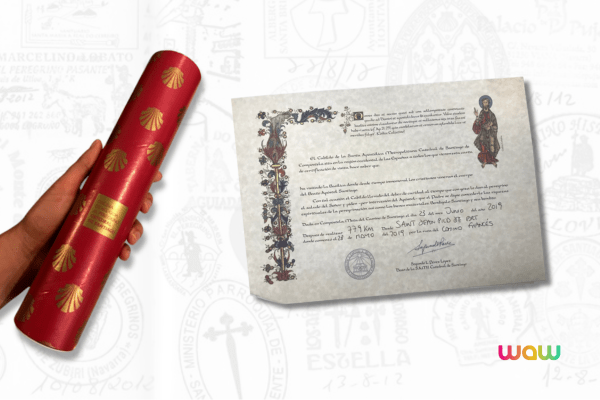IMPORTANT! Recent changes have updated the requirements for earning the Compostela certificate. Pilgrims are no longer required to complete the last 100 kilometers into Santiago. Instead, any 100 kilometers on any official Camino route will qualify as long as your final stage ends in Santiago. Additionally, according to the Canon of the Cathedral of Santiago de Compostela, pilgrims must now obtain two stamps per day on their route, not just during the last 100 kilometers as before.
How is it different from before?
Previously, pilgrims needed to complete the last 100 kilometers of the Camino de Santiago to qualify for the Compostela. These are the routes covering the final 100 kilometers:
- 1. Sarria to Santiago
- 2. Baiona to Santiago
- 3. Ourense to Santiago
- 4. Tui to Santiago
- 5. Lugo to Santiago
- 6. Ferrol to Santiago
- 7. Vilalba to Santiago
This requirement made the final stretches especially popular and often crowded. The new rule allows pilgrims greater flexibility in choosing their route while still ending their journey in Santiago de Compostela. Previously, pilgrims could stamp their credentials just once per day along the Camino, except for the last 100 kilometers, where two stamps per day were required.
Why is this new change?
The last 100 kilometers from Sarria to Santiago de Compostela is beautiful and a wonderful part of the Camino. But truthfully, it has become extremely popular and often very crowded. Many pilgrims have limited time available but still wish to receive their Compostela certificate, and rightfully so! This new rule is undoubtedly an effort to encourage people to explore other sections of the Camino Francés and other routes.
Which Camino fits the new rules to obtain the Compostela?
Make sure to always check the most up-to-date information about the Compostela before your Camino to be completely sure. The best way to do this is by visiting the website of the Pilgrims’ Office.
With the updated rules for earning the Compostela, pilgrims now have the flexibility to choose from a broader range of Camino routes. For example, you can complete sections of the Camino del Norte, such as the stretch from San Sebastián to Bilbao or from Santander to Gijón, and still qualify for the Compostela.
Important! If a pilgrim has already started a route on foot outside Spain along one of the routes recognized by the International Pilgrim’s Reception Office system, the required distance in Spain shall be no less than 70 kilometers. Just make sure you include at least one more stage leading up to Santiago de Compostela so that you can apply for your Compostela at the very end. It’s best to stay up to date by regularly checking the website of the Pilgrims’ Office while preparing for your journey.
You can complete the Camino in stages, as long as they follow chronological and geographical order. However, if you only walk the minimum required distance (the last 100 km on foot or 200 km by bike), you must always get your Credencial stamped at the start and end of each stage, including the corresponding date. This ensures that you have resumed the Camino from the exact place where you last stopped.
What is even the Compostela?
Over time, as the Camino de Santiago gained religious and social recognition, it became necessary to establish a way to verify that pilgrims had completed the journey. This led to the creation of the Compostela, the official certificate of pilgrimage.
Initially, pilgrims used scallop shells, known as the venera, as a symbol of their completed pilgrimage. These were available only in Santiago. However, the ease of counterfeiting these shells led to fraudulent sales near the city. To combat this, church authorities, including the Pope, issued strict penalties for counterfeiters. By the 13th century, the introduction of probatory letters provided a more secure form of certification. These documents are considered the direct precursors to the modern Compostela.
The Compostela in 2025
To obtain the Compostela, pilgrims must meet specific criteria:
- Walking pilgrimage: Walk at least 100 kilometers on any officially recognized Camino route. If a pilgrim has already started a route on foot outside Spain along one of the routes recognized by the International Pilgrim’s Reception Office system, the required distance in Spain shall be no less than 70 kilometers.
- Horseback pilgrimage: Ride at least 100 kilometers on any officially recognized Camino route. The final stage must include at least the last one leading into Santiago’s Cathedral.
- Cycling pilgrimage: Cycle at least 200 kilometers on an official route, following the same conditions as the pilgrimage on foot. Important! Cycling with e-bikes do not qualify you for the Compostela.
Once again: remember! Pilgrims must now collect at least two stamps per day throughout the entire Camino and not only the last 100 kilometers on their credential from official establishments to verify their journey.
The pilgrim registration process
Upon arriving at the Oficina del Peregrino, pilgrims must register by scanning a QR code and filling out the required information. They will receive an alphanumeric code, which must be noted on their credential. This code is required to obtain a ticket for Compostela collection, which includes a QR code to monitor the waiting time in real-time.Some more things to keep in mind:
- The Compostela is issued only in person and cannot be requested on behalf of others.
- Pilgrims may complete the Camino in stages, provided the stages are consecutive and chronologically ordered.
- The journey must lead to the Tomb of Saint James in Santiago de Compostela, following the chosen route without mixing different pilgrimage paths.
- The Compostela is issued free of charge.
Should you have any more questions, feel free to write to [email protected]!
What documents do I need to get the Compostela?
To obtain the Compostela, you must present your pilgrim credential (credencial del peregrino). This official document records your journey with stamps from churches, hostels, and other recognized places along the route. No passport or ID is required for the certificate itself, but you may need one when staying in accommodation or collecting stamps.
Where do I collect the Compostela once I finish the Camino?
The Compostela is issued at the Pilgrim’s Office in Santiago de Compostela, located near the Cathedral. Once you arrive, you present your stamped credential, wait for verification, and the staff will provide your certificate. During peak season, you may need to queue, so it’s best to arrive early in the day.
How many stamps are required each day to obtain the Compostela?
The Pilgrim’s Office requires at least two stamps per day if you are walking the last 100 km or cycling the last 200 km. These stamps must show the places you passed along the route, such as churches, albergues, or restaurants. Collecting more than two per day is allowed and often encouraged, as it provides a richer record of your Camino.



Comment (0)